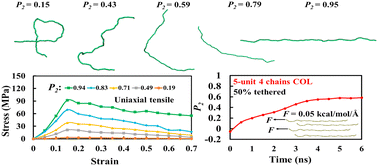Probing the alignment-dependent mechanical behaviors and time-evolutional aligning process of collagen scaffolds†
Abstract
Efficiently manipulating and reproducing collagen (COL) alignment in vitro remains challenging because many of the fundamental mechanisms underlying and guiding the alignment process are not known. We reconcile experiments and coarse-grained molecular dynamics simulations to investigate the mechanical behaviors of a growing COL scaffold and assay how changes in fiber alignment and various cross-linking densities impact their alignment dynamics under shear flow. We find higher cross-link densities and alignment levels significantly enhance the apparent tensile/shear moduli and strength of a bulk COL system, suggesting potential measures to facilitate the design of stronger COL based materials. Since fibril alignment plays a key factor in scaffold mechanics, we next investigate the molecular mechanism behind fibril alignment with Couette flow by computationally investigating the effects of COL's structural properties such as chain lengths, number of chains, tethering conditions, and initial COL conformations on the COL's final alignment level. Our computations suggest that longer chain lengths, more chains, greater amounts of tethering, and initial anisotropic COL conformations benefit the final alignment, but the effect of chain lengths may be more dominant over other factors. These results provide important parameters for consideration in manufacturing COL-based scaffolds where alignment and cross-linking are necessary for regulating performance.



 Please wait while we load your content...
Please wait while we load your content...
